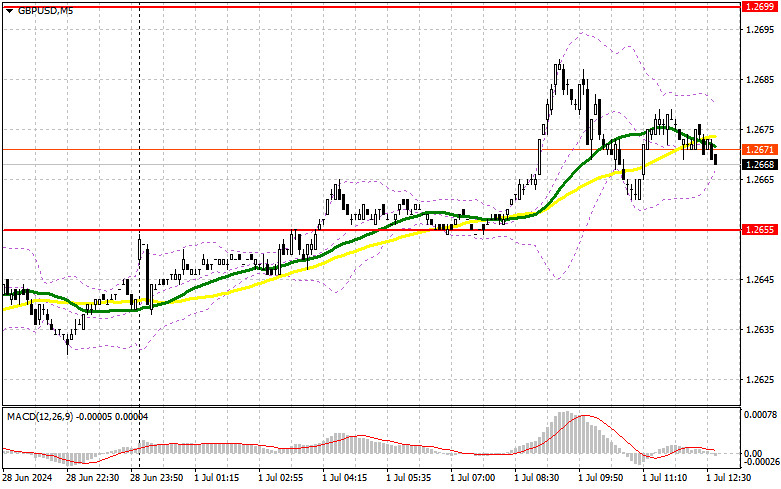
In my morning forecast, I focused on the level of 1.2699 and planned to make market entry decisions from it. Let's look at the 5-minute chart and see what happened. There was an increase, but it did not reach the test, and a false breakout did not form there. Thus, in the first half of the day, I was left without suitable entry points into the market. The technical picture was not revised for the second half of the day.

The ISM Manufacturing Index data is all that will interest us. The reaction to the American report could be significant given that similar statistics from the UK disappointed. For this reason, only an active defense of the 1.2655 support with a false breakout will provide a good entry point for long positions with the prospect of returning to and updating the 1.2699 resistance formed last week. A breakout and retest of 1.2699 from top to bottom amid weak ISM figures will restore the pound's upward potential, leading to an entry point for long positions and possibly updating the 1.2732 level. The furthest target will be the 1.2761 area, where I plan to take profit.
In the scenario of a GBP/USD decline and lack of bullish activity at 1.2655 in the second half of the day, where the moving averages also pass, pressure on the pair will return. This will also lead to a decline and update of the next support at 1.2613, increasing the chances of a bearish market development. Therefore, only a false breakout formation will be suitable for opening long positions. I plan to buy GBP/USD immediately on a rebound from the 1.2583 low with the aim of a 30-35 point intraday correction.
To open short positions on GBP/USD:Sellers took advantage of weak manufacturing statistics and prevented reaching a new weekly high. In the second half of the day, the focus will be on regaining control below 1.2655, but the defense of 1.2699 should not be forgotten either. A false breakout at this level will provide a suitable option for opening short positions to test the middle of the channel at 1.2655, where the moving averages, which favor the bulls, are also located. A breakout and retest of this range from bottom to top, along with strong US statistics, will hit the buyers' positions, leading to stop-loss orders being triggered and opening the way to 1.2613, the previous month's low. The furthest target will be the 1.2583 area, where I plan to take profit. Testing this level will strengthen the bearish market.
In the case of GBP/USD rising and a lack of activity at 1.2699 in the second half of the day, buyers will try to get a chance for an upward correction at the beginning of the week. In this case, I will delay sales until a false breakout at the 1.2732 level. If there is no downward movement, I will sell GBP/USD immediately on a rebound from 1.2761, but only in anticipation of a 30-35 point downward correction within the day.
The COT report (Commitment of Traders) for June 18 showed an increase in short positions and a slight decrease in long positions. The outcomes of the Bank of England meeting, where it was announced that rates in the UK could be cut as early as August this year, although not a revelation for traders, still influenced the market dynamics, leading to a sharp reduction in long positions. Additionally, the greater difference with the policy and actions of the Federal Reserve, which recently left interest rates unchanged and signaled only one possible rate cut this year, maintains demand for the US dollar and works in its favor. The latest COT report indicates that non-commercial long positions fell by 4,380 to 105,920, while non-commercial short positions increased by 120 to 58,299. As a result, the spread between long and short positions fell by 6,785.Indicator Signals:
Moving Averages
Trading occurs above the 30 and 50-day moving averages, indicating the pair's upward potential.
Note: The author considers the period and prices of the moving averages on the hourly H1 chart and differs from the general definition of classic daily moving averages on the daily D1 chart.
Bollinger Bands
In the event of a decline, the indicator's lower boundary, around 1.2625, will act as support.
Indicator Descriptions
Moving Average (determines the current trend by smoothing volatility and noise). Period 50. Marked in yellow on the chart.Moving Average (determines the current trend by smoothing volatility and noise). Period 30. Marked in green on the chart.MACD Indicator (Moving Average Convergence/Divergence - convergence/divergence of moving averages) Fast EMA period 12. Slow EMA period 26. SMA period 9.Bollinger Bands. Period 20.Non-commercial traders are speculators such as individual traders, hedge funds, and large institutions that use the futures market for speculative purposes and meet certain requirements.Long non-commercial positions represent the total long open position of non-commercial traders.Short non-commercial positions represent the total short open positions of non-commercial traders.The total non-commercial net position is the difference between non-commercial traders' short and long positions.